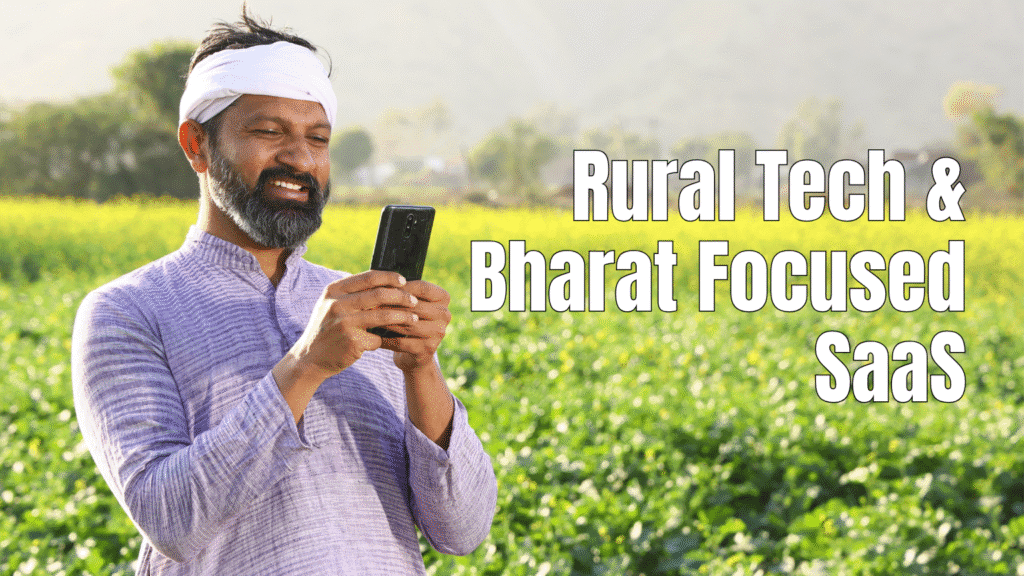As urban markets reach saturation, a silent but powerful shift is underway in India’s startup ecosystem: the rise of Bharat-focused and rural tech SaaS (Software as a Service) solutions. Startups are moving beyond Tier-I cities, designing products with vernacular UX, low-bandwidth support, and affordable pricing models tailored for the 800+ million people living in rural and semi-urban India.
Why Now? The Catalyst Behind the Shift
India’s Tier-II and Tier-III markets now account for more than 50% of digital consumption growth. With increasing smartphone penetration, UPI adoption, and government digitization initiatives like BharatNet and Digital India, rural and semi-urban consumers are more connected than ever.
Key enablers:
- Jio-led data revolution making high-speed internet accessible
- UPI transactions crossing ₹2,000 crore daily, even in small towns
- Digital public infrastructure (DPI) models like Aadhaar, Jan Dhan, and DigiLocker opening access
- Policy support like PM-WANI (WiFi), Startup India, and MSME credit facilitation
What’s Different About Bharat SaaS?
Unlike traditional SaaS tools built for urban enterprises or global markets, Bharat-focused SaaS startups are:
- Language-first: Apps in Hindi, Marathi, Tamil, Kannada, Bengali, and other regional tongues
- Mobile-first, offline capable: Optimized for patchy networks and low-end Android devices
- Pay-as-you-go models: Low subscription pricing, often as low as ₹50–₹200 per month
- Localized onboarding: Video and voice-led walkthroughs instead of dense UI/UX
- Trust channels: Distributed via local influencers, kirana stores, or panchayat-level partnerships
Who’s Leading the Bharat SaaS Wave?
Here are some fast-growing startups making waves in the rural and semi-urban tech space:
- Kissht and ZestMoney – offering consumer credit access to first-time borrowers
- DeHaat, AgNext, and Gramophone – building full-stack agritech platforms
- OKCredit and Khatabook – digitizing small business and kirana transactions
- SARAL and Kutumb – creating vernacular social and community platforms
- BharatAgri – precision farming advisory for smallholder farmers via mobile
What Investors Are Watching
Venture capital is taking note. Bharat-focused SaaS has drawn serious backing from:
- Sequoia’s Surge and Accel in agritech and local commerce
- Omidyar Network India and Aavishkaar Capital in financial inclusion
- Blume Ventures in social commerce and regional enterprise tools
The 2024–25 investment cycle saw over $500 million in early-stage deals in rural tech alone, with sectors like agri-fintech, MSME SaaS, and healthcare logistics showing sharp upward trends.
What’s Next?
The Bharat SaaS boom is expected to grow in 2025 and beyond due to:
- India’s growing DPI stack and ONDC rollout
- Demand for hyperlocal digitization from MSMEs and rural service providers
- Emerging verticals: education, telemedicine, logistics, and clean-tech in non-metros
By 2027, experts forecast that 25–30% of India’s SaaS revenues could come from Bharat, unlocking a new blueprint for inclusive innovation.
Final Thoughts
Rural tech and Bharat-focused SaaS aren’t just feel-good impact stories—they represent scalable, high-growth opportunities in one of the world’s most unique and complex markets. Founders building for Bharat are combining language empathy, UX intuition, and distribution hackery to unlock the next 500 million internet users.
The next unicorns may not come from Bengaluru or Mumbai, but from Bhopal, Bhubaneswar, or Bareilly—quietly coding the future of India, in the language of Bharat.



